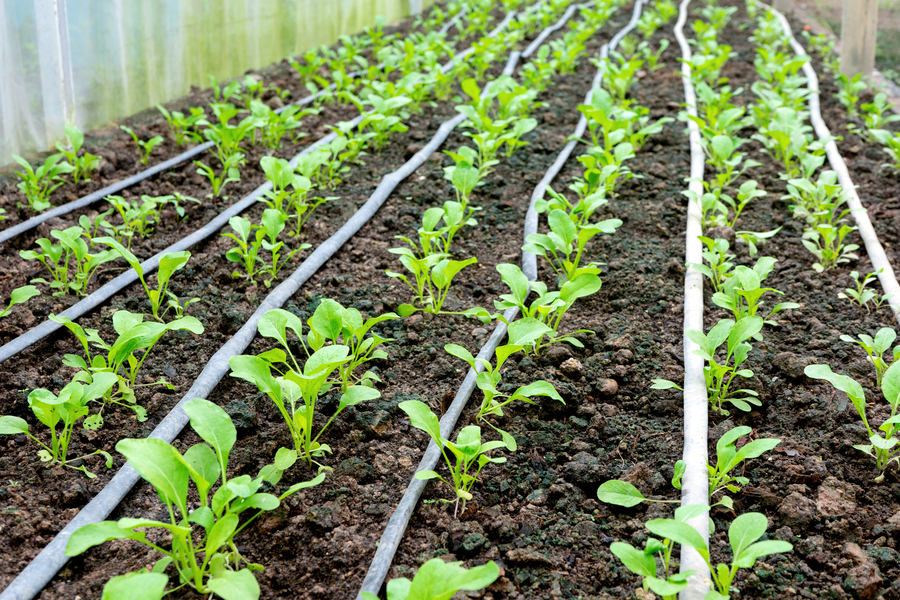Posted On: May 06, 2025
Posted By: KSNM DRIP

Drip irrigation is a modern and simple method of watering crops that is gaining popularity among Indian farmers. Instead of flooding the whole field, drip irrigation sends small amounts of water directly to the base of each plant. This method saves water, time, and money, and it is especially helpful for growing valuable spices like pepper and cardamom.
Spice plants like pepper and cardamom need regular moisture, but they don’t like standing water. Drip irrigation gives just the right amount of water at the root zone. This method also helps avoid weed growth and diseases that spread through too much water.
It also allows the farmer to add fertilizers directly through the drip system, a process called fertigation. This saves fertilizer and gives better results. By using drip, you can expect better crop health, stronger plants, and a good harvest.
Pepper is known as the "King of Spices." It grows on vines and is usually planted near trees or supports. This crop needs shade, humidity, and consistent moisture to grow well. Using drip irrigation for pepper ensures that the water reaches only the roots and not the leaves, which can cause fungal infections.
Soil: Well-drained loamy soil with good organic matter is best.
Climate: Warm and humid climate is suitable. Pepper grows well in partial shade.
Dripper spacing: Keep the drippers 30 to 45 cm away from the base of the plant.
Water output (discharge rate): Use emitters with 4 litres per hour (LPH).
Watering frequency: Water every 2 to 3 days during dry periods.
Water needed: Around 6 to 8 litres per plant per day in hot weather.
Use mulching (dry leaves or coconut husk) around the plant base to save moisture.
Combine drip irrigation with fertigation during flowering and fruit setting.
Always check drainage. Water should not stay around the roots for long.
Use shade trees or nets to protect the vines from direct sunlight.
Using drip irrigation, farmers have seen an increase in yield by 25% to 40%. Also, the berries are larger, and the plants are healthier.
Cardamom, also called the "Queen of Spices," is a high-value crop grown mostly in hilly and tropical areas. It grows best in humid places with filtered sunlight. Cardamom plants need regular and gentle watering. Drip irrigation is perfect because it gives water slowly and directly to the roots.
Soil: Rich loamy soil with a lot of organic matter.
Climate: Tropical climate with good rainfall. Grows well under shade.
Dripper spacing: Place drippers 45 to 60 cm away from each plant.
Water output (discharge rate): 2 to 4 litres per hour.
Watering frequency: Water every 2 to 3 days in dry season.
Water needed: 4 to 6 litres per plant per day.
Avoid too much water, especially during rainy months.
Mulch the base to retain soil moisture and keep roots cool.
Use fertigation for better flower and pod formation.
Make sure shade trees are maintained to avoid heat stress.
Drip irrigation in cardamom fields helps maintain constant moisture, which is key for flowering and pod development. Farmers using drip have reported more uniform pods and better quality.
Fertigation means adding fertilizer through the drip system. This is one of the best uses of drip irrigation. It sends nutrients directly to the roots, where the plant needs them most. This also reduces waste and cost.
Below is a simple fertigation schedule for both pepper and cardamom:
Always test your soil before deciding the quantity of fertilizer. Use only the amount needed.
Drip irrigation is not just about saving water. It brings many benefits, especially for spice crops:
Saves Water: Up to 60% less water used compared to traditional methods.
Increases Yield: Plants get water and nutrients regularly, leading to better harvest.
Saves Time and Labor: No need to water plants manually. It can be automated.
Less Disease: Water only at the roots means less fungus and disease.
Better Fertilizer Use: Fertilizers go directly to the roots.
No Weeds: Dry topsoil means fewer weeds.
Farmers who switched to drip irrigation have seen better plant growth and income. It also helps during droughts, as less water is needed.
Starting with drip irrigation is simple. You can either buy a ready-made kit or get help from local agricultural offices. Many states in India also offer government subsidies for drip irrigation systems.
Know your farm size and crop spacing.
Choose the right pipes and emitters.
Install a water filter to keep the system clean.
Connect a fertilizer tank if you want fertigation.
Lay the pipes near the base of each plant.
Test the system for leaks.
Set a timer or water manually as needed
Use clean water to prevent emitter blockage.
Clean the filters once every 2 weeks.
Check for leaks or blocked emitters regularly.
Don’t overwater. Stick to the recommended quantity.
Try using organic fertilizers in fertigation to improve soil health.
If you are growing pepper or cardamom and want to increase your yield with less water and effort, drip irrigation is a smart and safe choice.
Pepper and cardamom are valuable crops that need careful watering. Drip irrigation is a farmer-friendly solution that saves water, time, and fertilizer. It also improves crop quality and quantity. With the help of this system, even small farmers can get big results.
If you’re planning to try drip irrigation on your spice farm, talk to local experts or suppliers. A small change in your irrigation method can bring big improvements in your harvest.